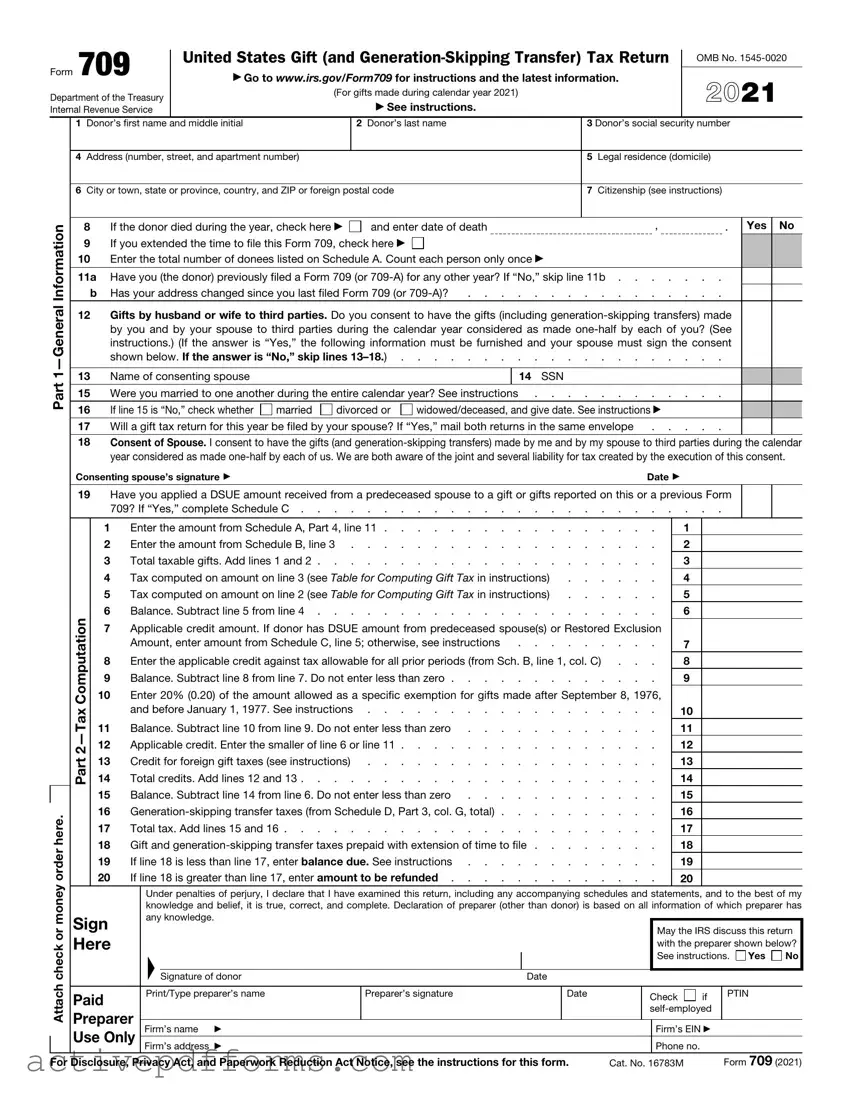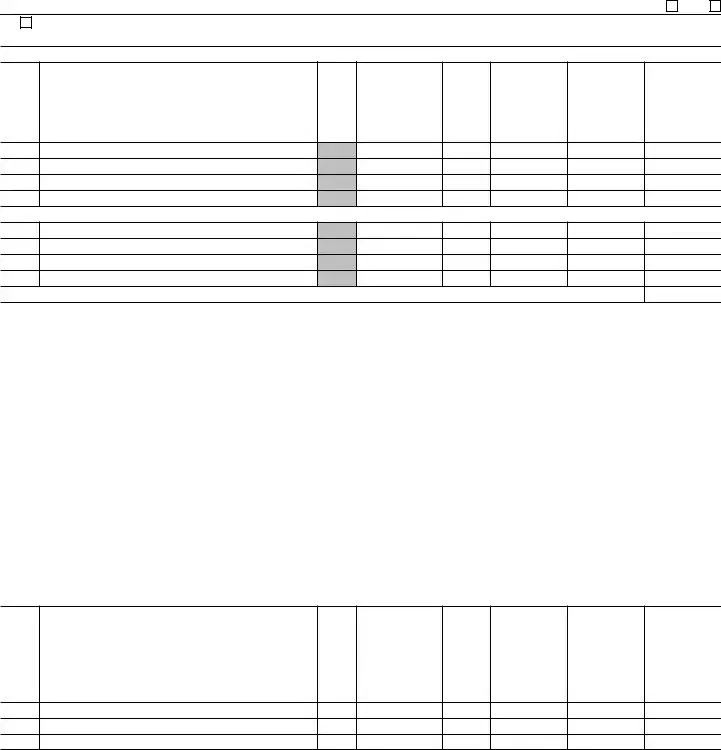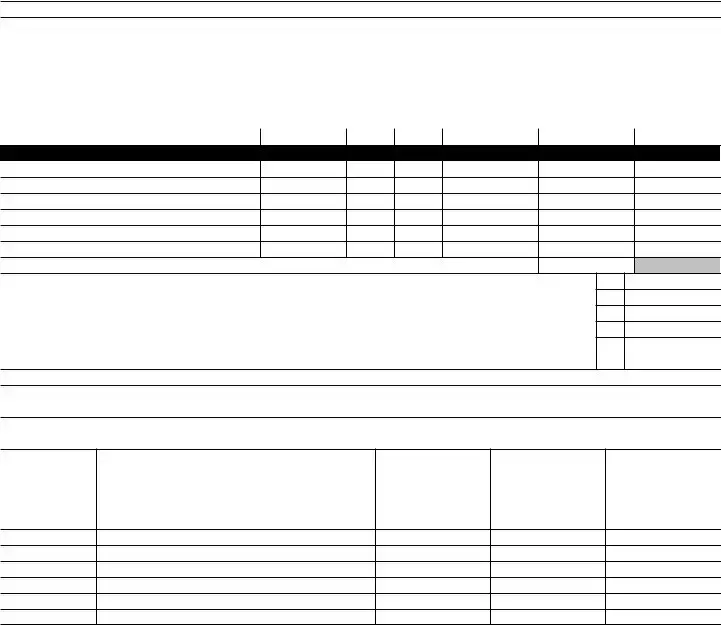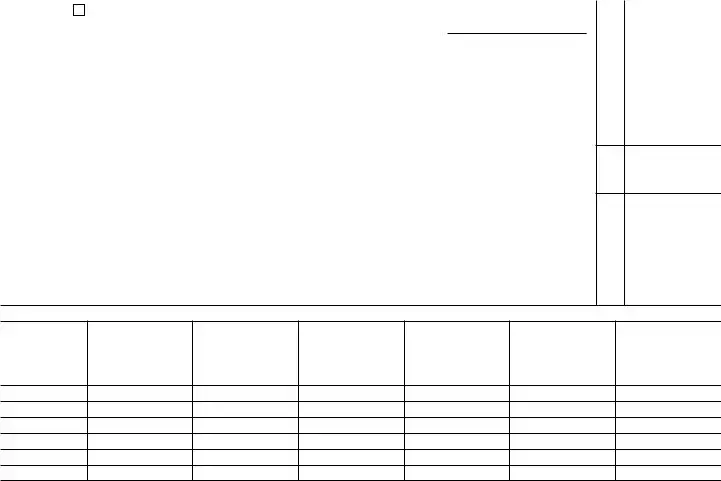
|
|
|
|
|
|
|
|
|
|
|
|
|
|
|
|
|
Form 709 |
|
United States Gift (and Generation-Skipping Transfer) Tax Return |
|
OMB No. 1545-0020 |
|
|
|
▶ Go to www.irs.gov/Form709 for instructions and the latest information. |
|
2021 |
Department of the Treasury |
|
|
|
(For gifts made during calendar year 2021) |
|
|
|
|
|
|
|
▶ See instructions. |
|
|
|
Internal Revenue Service |
|
|
|
|
|
|
|
|
1 Donor’s first name |
|
and middle initial |
|
|
2 Donor’s last name |
|
|
|
3 Donor’s social security number |
|
|
|
|
|
|
|
|
|
|
|
|
4 Address (number, street, and apartment number) |
|
|
|
|
|
|
5 Legal residence (domicile) |
|
|
|
|
|
|
|
|
|
|
6 City or town, state or province, country, and ZIP or foreign postal code |
|
|
|
|
7 Citizenship (see instructions) |
|
|
|
|
|
|
|
|
|
|
|
Information |
8 |
If the donor died during the year, check here ▶ |
and enter date of death |
, |
|
. |
Yes |
No |
9 |
If you extended the time to file this Form 709, check here ▶ |
|
|
|
|
|
|
|
|
|
|
|
|
|
|
|
|
|
|
|
|
10 |
Enter the total number of donees listed on Schedule A. Count each person only once ▶ |
|
|
|
|
|
11a |
Have you (the donor) previously filed a Form 709 (or 709-A) for any other year? If “No,” skip line 11b |
|
|
|
b |
Has your address changed since you last filed Form 709 (or 709-A)? |
. . . . . . . . . . . . . . . . |
|
|
1—General |
12 |
Gifts by husband or wife to third parties. Do you consent to have the gifts (including generation-skipping transfers) made |
|
|
|
|
|
|
|
by you and by your spouse to third parties during the calendar year considered as made one-half by each of you? (See |
|
|
|
|
instructions.) (If the answer is “Yes,” the following information must be furnished and your spouse must sign the consent |
|
|
|
|
shown below. If the answer is “No,” skip lines 13–18.) |
|
|
|
|
|
|
|
|
|
|
|
|
|
|
|
|
Part |
13 |
Name of consenting spouse |
|
|
|
|
|
|
14 SSN |
|
|
|
|
15 |
Were you married to one another during the entire calendar year? See instructions |
|
|
|
|
|
|
16 |
If line 15 is “No,” check whether |
married |
divorced or |
widowed/deceased, and give date. See instructions ▶ |
|
|
|
|
|
17 |
Will a gift tax return for this year be filed by your spouse? If “Yes,” mail both returns in the same envelope |
|
|
18Consent of Spouse. I consent to have the gifts (and generation-skipping transfers) made by me and by my spouse to third parties during the calendar year considered as made one-half by each of us. We are both aware of the joint and several liability for tax created by the execution of this consent.
Consenting spouse’s signature ▶ |
Date ▶ |
19Have you applied a DSUE amount received from a predeceased spouse to a gift or gifts reported on this or a previous Form
709? If “Yes,” complete Schedule C . . . . . . . . . . . . . . . . . . . . . . . . . .
|
|
|
1 |
Enter the amount from Schedule A, Part 4, line 11 |
. . . |
|
1 |
|
|
|
|
|
|
2 |
Enter the amount from Schedule B, line 3 |
. . . |
|
2 |
|
|
|
|
|
|
3 |
Total taxable gifts. Add lines 1 and 2 |
. . . |
|
3 |
|
|
|
|
|
|
4 |
Tax computed on amount on line 3 (see Table for Computing Gift Tax in instructions) . . . |
. . . |
|
4 |
|
|
|
|
|
|
5 |
Tax computed on amount on line 2 (see Table for Computing Gift Tax in instructions) . . . |
. . . |
|
5 |
|
|
|
|
|
Computation |
6 |
Balance. Subtract line 5 from line 4 |
. . . |
|
6 |
|
|
|
|
|
7 |
Applicable credit amount. If donor has DSUE amount from predeceased spouse(s) or Restored Exclusion |
|
|
|
|
|
|
|
|
|
|
|
|
|
|
|
|
|
Amount, enter amount from Schedule C, line 5; otherwise, see instructions |
. . . |
|
7 |
|
|
|
|
|
|
8 |
Enter the applicable credit against tax allowable for all prior periods (from Sch. B, line 1, col. C) |
. . . |
|
8 |
|
|
|
|
|
|
9 |
Balance. Subtract line 8 from line 7. Do not enter less than zero |
. . . |
|
9 |
|
|
|
|
|
|
10 |
Enter 20% (0.20) of the amount allowed as a specific exemption for gifts made after September 8, 1976, |
|
|
|
|
|
|
|
2—Tax |
|
and before January 1, 1977. See instructions |
. . . |
|
10 |
|
|
|
|
|
11 |
Balance. Subtract line 10 from line 9. Do not enter less than zero |
. . . |
|
11 |
|
|
|
|
|
|
|
|
|
|
|
|
|
12 |
Applicable credit. Enter the smaller of line 6 or line 11 |
. . . |
|
12 |
|
|
|
|
|
Part |
13 |
Credit for foreign gift taxes (see instructions) |
. . . |
|
13 |
|
|
|
|
|
14 |
Total credits. Add lines 12 and 13 |
. . . |
|
14 |
|
|
|
|
|
|
15 |
Balance. Subtract line 14 from line 6. Do not enter less than zero |
. . . |
|
15 |
|
|
|
here. |
|
16 |
Generation-skipping transfer taxes (from Schedule D, Part 3, col. G, total) |
. . . |
|
16 |
|
|
|
|
17 |
Total tax. Add lines 15 and 16 |
. . . |
|
17 |
|
|
|
|
|
|
|
|
|
|
order |
|
18 |
Gift and generation-skipping transfer taxes prepaid with extension of time to file |
. . . |
|
18 |
|
|
|
|
19 |
If line 18 is less than line 17, enter balance due. See instructions |
. . . |
|
19 |
|
|
|
|
|
|
|
|
|
|
money |
|
|
20 |
If line 18 is greater than line 17, enter amount to be refunded |
. . . |
|
20 |
|
|
|
|
|
|
|
Under penalties of perjury, I declare that I have examined this return, including any accompanying schedules and statements, and to the best of my |
|
|
|
|
|
|
|
|
|
|
knowledge and belief, it is true, correct, and complete. Declaration of preparer (other than donor) is based on all information of which preparer has |
|
|
Sign |
|
any knowledge. |
|
|
|
|
|
|
|
|
|
|
|
or |
|
|
|
|
|
|
|
|
May the IRS discuss this return |
Here |
|
|
|
|
|
|
|
|
|
|
|
|
|
|
|
|
with the preparer shown below? |
check |
|
|
|
|
|
|
|
|
|
|
|
▲ |
|
|
|
|
|
|
See instructions. Yes |
No |
|
|
|
|
|
|
|
|
|
|
|
|
|
|
|
|
|
|
|
|
|
|
|
|
|
Signature of donor |
|
Date |
|
|
|
|
|
|
|
|
Attach |
|
|
|
|
|
|
|
|
|
|
|
|
|
|
|
|
|
|
Paid |
|
Print/Type preparer’s name |
Preparer’s signature |
|
Date |
|
Check |
|
if |
PTIN |
|
|
|
|
|
|
|
|
|
|
|
|
|
|
|
|
|
|
|
|
|
|
|
|
|
|
|
|
|
Preparer |
|
|
|
|
|
|
self-employed |
|
|
|
|
|
|
|
|
|
|
|
|
|
|
|
|
|
|
|
Firm’s name ▶ |
|
|
|
|
|
Firm’s EIN ▶ |
|
|
|
|
Use Only |
|
|
|
|
|
|
|
|
|
Firm’s address ▶ |
|
|
|
|
|
Phone no. |
|
|
|
|
|
|
|
|
|
|
|
|
|
|
For Disclosure, Privacy Act, and Paperwork Reduction Act Notice, see the instructions for this form. |
Cat. No. 16783M |
Form 709 (2021) |
Form 709 (2021) |
Page 2 |
SCHEDULE A |
Computation of Taxable Gifts (Including transfers in trust) (see instructions) |
|
A Does the value of any item listed on Schedule A reflect any valuation discount? If “Yes,” attach explanation . . . . . . Yes |
No |
◀Check here if you elect under section 529(c)(2)(B) to treat any contributions made this year to a qualified tuition program as made ratably over a 5-year period beginning this year. See instructions. Attach explanation.
Part 1—Gifts Subject Only to Gift Tax. Gifts less political organization, medical, and educational exclusions. See instructions.
A |
B |
C |
D |
E |
F |
G |
H |
Item |
• Donee’s name and address |
|
Donor’s adjusted |
Date |
Value at |
For split gifts, |
Net transfer |
number |
• Relationship to donor (if any) |
|
basis of gift |
of gift |
date of gift |
enter 1/2 of |
(subtract col. G |
|
• Description of gift |
|
|
|
|
column F |
from col. F) |
|
• If the gift was of securities, give CUSIP no. |
|
|
|
|
|
|
|
• If closely held entity, give EIN |
|
|
|
|
|
|
1
Gifts made by spouse—complete only if you are splitting gifts with your spouse and he/she also made gifts.
Total of Part 1. Add amounts from Part 1, column H . . . . . . . . . . . . . . . . . . . . . . ▶
Part 2—Direct Skips. Gifts that are direct skips and are subject to both gift tax and generation-skipping transfer tax. You must list the gifts in chronological order.
A |
B |
C |
D |
E |
F |
G |
H |
Item |
• Donee’s name and address |
2632(b) |
Donor’s adjusted |
Date |
Value at |
For split gifts, |
Net transfer |
number |
• Relationship to donor (if any) |
election |
basis of gift |
of gift |
date of gift |
enter 1/2 of |
(subtract col. G |
|
• Description of gift |
out |
|
|
|
column F |
from col. F) |
|
• If the gift was of securities, give CUSIP no. |
|
|
|
|
|
|
|
• If closely held entity, give EIN |
|
|
|
|
|
|
|
|
|
|
|
|
|
|
1 |
|
|
|
|
|
|
|
|
|
|
|
|
|
|
|
|
|
|
|
|
|
|
|
|
|
|
|
|
|
|
|
Gifts made by spouse—complete only if you are splitting gifts with your spouse and he/she also made gifts. |
|
|
|
|
|
|
|
|
|
|
|
|
|
|
|
|
|
|
|
|
|
|
|
|
|
|
|
|
|
|
|
|
|
|
|
|
|
Total of Part 2. Add amounts from Part 2, column H |
. . . ▶ |
|
Part 3—Indirect Skips and Other Transfers in Trust. Gifts to trusts that are indirect skips as defined under section 2632(c) or to trusts that are currently subject to gift tax and may later be subject to generation-skipping transfer tax. You must list these gifts in chronological order.
A |
B |
C |
D |
E |
F |
G |
H |
Item |
• Donee’s name and address |
2632(c) |
Donor’s adjusted |
Date |
Value at |
For split gifts, |
Net transfer |
number |
• Relationship to donor (if any) |
election |
basis of gift |
of gift |
date of gift |
enter 1/2 of |
(subtract col. G |
|
• Description of gift |
|
|
|
|
column F |
from col. F) |
|
• If the gift was of securities, give CUSIP no. |
|
|
|
|
|
|
|
• If closely held entity, give EIN |
|
|
|
|
|
|
|
|
|
|
|
|
|
|
1 |
|
|
|
|
|
|
|
Gifts made by spouse—complete only if you are splitting gifts with your spouse and he/she also made gifts.
|
|
|
|
|
|
|
|
|
|
|
|
|
|
|
|
|
|
|
|
|
|
|
|
|
|
|
|
|
|
|
|
|
|
|
|
Total of Part 3. Add amounts from Part 3, column H |
▶ |
|
(If more space is needed, attach additional statements.) |
|
Form 709 (2021) |

Form 709 (2021) |
Page 3 |
Part 4—Taxable Gift Reconciliation |
|
1 |
Total value of gifts of donor. Add totals from column H of Parts 1, 2, and 3 |
1 |
2 |
Total annual exclusions for gifts listed on line 1 (see instructions) |
2 |
3 |
Total included amount of gifts. Subtract line 2 from line 1 |
3 |
Deductions (see instructions) |
|
4Gifts of interests to spouse for which a marital deduction will be claimed, based on item
|
numbers |
of Schedule A |
|
4 |
|
|
5 |
Exclusions attributable to gifts on line 4 . . |
. . . . . . . . . . . . |
|
5 |
|
|
6 |
Marital deduction. Subtract line 5 from line 4 . |
. . . . . . . . . . . . |
|
6 |
|
|
7 |
Charitable deduction, based on item numbers |
less exclusions |
|
7 |
|
|
8 |
Total deductions. Add lines 6 and 7 . . . |
. . . . . . . . . . . . |
. . . . . . . . |
|
8 |
9 |
Subtract line 8 from line 3 |
. . . . . . . . . . . . |
. . . . . . . . |
|
9 |
10 |
Generation-skipping transfer taxes payable with this Form 709 (from Schedule D, Part 3, col. G, total) . . . . |
|
10 |
11 |
Taxable gifts. Add lines 9 and 10. Enter here and on page 1, Part 2—Tax Computation, line 1 |
11 |
Terminable Interest (QTIP) Marital Deduction. (See instructions for Schedule A, Part 4, line 4.)
If a trust (or other property) meets the requirements of qualified terminable interest property under section 2523(f), and: a. The trust (or other property) is listed on Schedule A; and
b. The value of the trust (or other property) is entered in whole or in part as a deduction on Schedule A, Part 4, line 4, then the donor shall be deemed to have made an election to have such trust (or other property) treated as qualified terminable interest property under section 2523(f).
If less than the entire value of the trust (or other property) that the donor has included in Parts 1 and 3 of Schedule A is entered as a deduction on line 4, the donor shall be considered to have made an election only as to a fraction of the trust (or other property). The numerator of this fraction is equal to the amount of the trust (or other property) deducted on Schedule A, Part 4, line 6. The denominator is equal to the total value of the trust (or other property) listed in Parts 1 and 3 of Schedule A.
If you make the QTIP election, the terminable interest property involved will be included in your spouse’s gross estate upon his or her death (section 2044). See instructions for line 4 of Schedule A. If your spouse disposes (by gift or otherwise) of all or part of the qualifying life income interest, he or she will be considered to have made a transfer of the entire property that is subject to the gift tax. See Transfer of Certain Life Estates Received From Spouse in the instructions.
12Election Out of QTIP Treatment of Annuities

 ◀ Check here if you elect under section 2523(f)(6) not to treat as qualified terminable interest property any joint and survivor annuities that are reported on Schedule A and would otherwise be treated as qualified terminable interest property under section 2523(f). See instructions. Enter the item numbers from Schedule A for the annuities for which you are making this election ▶
◀ Check here if you elect under section 2523(f)(6) not to treat as qualified terminable interest property any joint and survivor annuities that are reported on Schedule A and would otherwise be treated as qualified terminable interest property under section 2523(f). See instructions. Enter the item numbers from Schedule A for the annuities for which you are making this election ▶
SCHEDULE B Gifts From Prior Periods
If you answered “Yes” on line 11a of page 1, Part 1, see the instructions for completing Schedule B. If you answered “No,” skip to the Tax Computation on page 1 (or Schedule C or D, if applicable). Complete Schedule A before beginning Schedule B. See instructions for recalculation of the column C amounts. Attach calculations.
A
Calendar year or calendar quarter (see instructions)
B
Internal Revenue office
where prior return was filed
C |
D |
Amount of applicable |
Amount of specific |
credit (unified credit) |
exemption for prior |
against gift tax |
periods ending before |
for periods after |
January 1, 1977 |
December 31, 1976 |
|
E
Amount of
taxable gifts
1 |
Totals for prior periods |
1 |
|
|
2 |
Amount, if any, by which total specific exemption, line 1, column D, is more than $30,000 |
. . . . . . . |
2 |
3Total amount of taxable gifts for prior periods. Add amount on line 1, column E, and amount, if any, on line 2. Enter
here and on page 1, Part 2—Tax Computation, line 2 |
3 |
(If more space is needed, attach additional statements.) |
Form 709 (2021) |
SCHEDULE C Deceased Spousal Unused Exclusion (DSUE) Amount and Restored Exclusion
Provide the following information to determine the DSUE amount and applicable credit received from prior spouses. Complete Schedule A before beginning Schedule C.
A |
B |
|
C |
D |
E |
F |
Name of deceased spouse |
Date of death |
Portability election |
If “Yes,” DSUE |
DSUE amount applied |
Date of gift(s) |
(dates of death after December 31, 2010, only) |
|
|
made? |
amount received |
by donor to lifetime |
(enter as mm/dd/yy |
|
|
|
|
|
from spouse |
gifts (list current |
for Part 1 and as |
|
|
Yes |
|
No |
|
and prior gifts) |
yyyy for Part 2) |
|
|
|
|
|
|
|
|
|
|
|
|
|
|
Part 1—DSUE RECEIVED FROM LAST DECEASED SPOUSE |
|
|
|
|
|
Part 2—DSUE RECEIVED FROM PREDECEASED SPOUSE(S)
TOTAL (for all DSUE amounts applied from column E for Part 1 and Part 2) . . . . . . . . . ▶
1 |
Donor’s basic exclusion amount (see instructions) |
2 |
Total from column E, Parts 1 and 2 |
3 |
Restored Exclusion Amount (see instructions) |
4 |
Add lines 1, 2, and 3 |
5Applicable credit on amount in line 4 (see Table for Computing Gift Tax in the instructions). Enter here and on line 7,
Part 2—Tax Computation . . . . . . . . . . . . . . . . . . . . . . . . . .
SCHEDULE D Computation of Generation-Skipping Transfer Tax
Note: Inter vivos direct skips that are completely excluded by the GST exemption must still be fully reported (including value and exemptions claimed) on Schedule D.
Part 1—Generation-Skipping Transfers. List items from Schedule A first, then items to be reported on Schedule D, including any transfers subject to an Estate Tax Inclusion Period (ETIP).
A |
B |
C |
D |
E |
Item number |
Description |
Value |
Nontaxable |
Net transfer |
(from Schedule A, |
(only for ETIP transfers) |
(from Schedule A, |
portion of transfer |
(subtract col. D |
Part 2, col. A, then |
|
Part 2, col. H, |
|
from col. C) |
ETIP transfers, |
|
or close of ETIP |
|
|
if any) |
|
described in col. B) |
|
|
1
Gifts made by spouse (for gift splitting only)
|
|
|
|
|
|
|
|
|
|
|
|
|
|
|
|
|
|
|
|
|
|
|
|
|
|
|
|
|
|
(If more space is needed, attach additional statements.) |
|
|
Form 709 (2021) |
|
|
|
|
|
Form 709 (2021) |
|
|
Page 5 |
Part 2—GST Exemption Reconciliation (Section 2631) and Section 2652(a)(3) Election |
|
Check here ▶ |
if you are making a section 2652(a)(3) (special QTIP) election. See instructions. |
|
Enter the item numbers from Schedule A of the gifts for which you are making this election ▶ |
|
1 |
Maximum allowable exemption (see instructions) |
. . . . . . . . . . . . . . . . . . . |
1 |
2 |
Total exemption used for periods before filing this return |
2 |
3 |
Exemption available for this return. Subtract line 2 from line 1 |
3 |
4 |
Exemption claimed on this return from Part 3, column C, total below |
4 |
5Automatic allocation of exemption to transfers reported on Schedule A, Part 3. To opt out of the automatic
allocation rules, you must attach an “Election Out” statement. See instructions |
5 |
6Exemption allocated to transfers not shown on line 4 or line 5 above. You must attach a “Notice of Allocation.”
|
See instructions |
6 |
7 |
Add lines 4, 5, and 6 |
7 |
8 |
Exemption available for future transfers. Subtract line 7 from line 3 |
8 |
Part 3—Tax Computation
A |
B |
C |
D |
E |
F |
G |
Item number |
Net transfer |
GST exemption |
Divide col. C |
Inclusion ratio |
Applicable rate |
Generation-skipping |
(from Schedule D, |
(from Schedule D, |
allocated |
by col. B |
(Subtract col. D |
(multiply col. E |
transfer tax |
Part 1) |
Part 1, col. E) |
|
|
from 1.000) |
by 40% (0.40)) |
(multiply col. B |
|
|
|
|
|
|
by col. F) |
1
Gifts made by spouse (for gift splitting only)
|
|
|
|
|
|
|
|
|
|
|
|
|
|
|
|
|
|
|
|
|
|
|
|
|
|
|
|
|
|
|
|
|
|
|
|
|
|
|
|
|
|
Total exemption claimed. Enter here |
|
Total generation-skipping transfer tax. Enter here; on page |
|
and on Part 2, line 4, above. May not |
|
3, Schedule A, Part 4, line 10; and on page 1, Part 2—Tax |
|
exceed Part 2, line 3, above . . . |
|
Computation, line 16 |
|
|
|
|
|
|
|
|
(If more space is needed, attach additional statements.) |
|
|
|
Form 709 (2021) |







